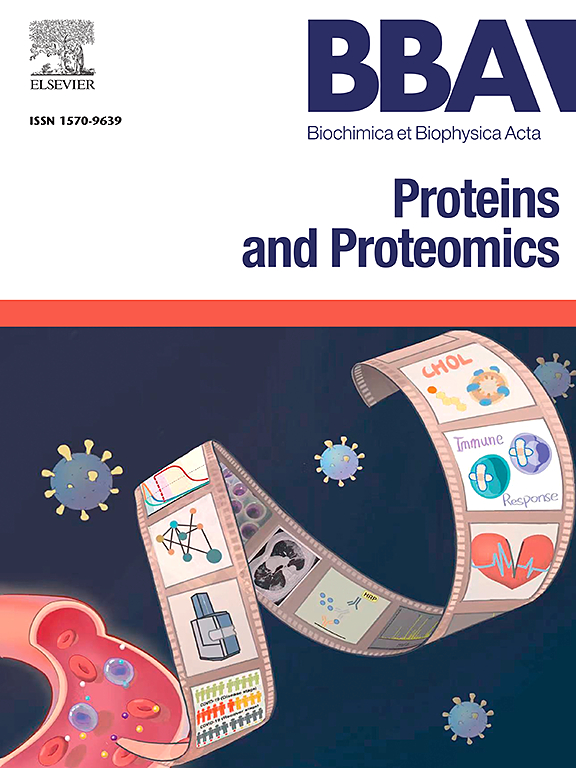静电在冷适应中的作用:欧洲人和斯坦人亲水性磷酸三糖异构酶的比较研究
IF 2.3
4区 生物学
Q3 BIOCHEMISTRY & MOLECULAR BIOLOGY
Biochimica et biophysica acta. Proteins and proteomics
Pub Date : 2025-04-11
DOI:10.1016/j.bbapap.2025.141072
引用次数: 0
摘要
嗜冷(冷活性)生物已经发展出酶,在低温下促进足够的代谢活动来维持生命。这是通过分子适应来实现的,这种适应倾向于以牺牲稳定性为代价来增加蛋白质的灵活性。然而,嗜冷菌的生长条件也各不相同。宽亲氧菌在很宽的温度范围内茁壮成长,通常更喜欢20°C以上的温度,而窄亲氧菌的最佳生长温度低于15°C,更适应寒冷的温度。为了阐明这两类酶之间的差异,我们在这里比较了基础家庭酶磷酸三糖异构酶的两个同源物的稳定性和展开动力学,一个来自南极永冻带窄亲性细菌Rhodonellum psychrophilum (sTPI),另一个来自泛亲性格陵兰冰岩柱细菌Rhodococcus sp. JG-3 (eTPI)。值得注意的是,在溶液中不含离子成分的情况下,sTPI的热稳定性和耐化学变性性明显优于其泛亲性的eTPI,而在溶液中加入氯化钠或带电变性剂氯化胍等静电筛选剂在很大程度上抵消了这种差异。因此,静电在稳定窄亲性sTPI中起着突出的作用,强制性的低温生长环境并不妨碍对单个酶的相当大的耐热性的发展。我们能够使用进化机器学习模型提高sTPI的热稳定性,该模型将几个sTPI残基转移到eTPI活性位点。虽然稳定作用是适度的,但单个突变的组合是加性的,强调了组合多个有益突变以实现增强酶特性的潜力。本文章由计算机程序翻译,如有差异,请以英文原文为准。
Role of electrostatics in cold adaptation: A comparative study of eury- and stenopsychrophilic triose phosphate isomerase
Psychrophilic (cold-active) organisms have developed enzymes that facilitate sufficient metabolic activity at low temperatures to sustain life. This occurs through molecular adaptations that tend to increase protein flexibility at the expense of stability. However, psychrophiles also vary in their growth conditions. Eurypsychrophiles thrive over a wide temperature range and often prefer temperatures above 20 °C, while stenopsychrophiles grow optimally below 15 °C and are more narrowly adapted to cold temperatures. To elucidate differences between these two classes of enzymes, we here compare the stability and unfolding kinetics of two orthologues of the basal household enzyme triose phosphate isomerase, one from the stenopsychrophilic Antarctic permafrost bacterium Rhodonellum psychrophilum (sTPI) and the other from the eurypsychrophilic Greenland ikaite column bacterium Rhodococcus sp. JG-3 (eTPI). Remarkably, sTPI proved significantly more thermostable and resistant to chemical denaturation than its eurypsychrophilic counterpart, eTPI, in the absence of ionic components in solution, whereas inclusion of electrostatic screening agents in the form of sodium chloride or the charged denaturant guanidinium chloride largely cancelled out this difference. Thus, electrostatics play a prominent role in stabilizing the stenopsychrophilic sTPI, and a mandatory low-temperature growth environment does not preclude the development of considerable thermotolerance for individual enzymes. We were able to increase the thermostability of sTPI using an evolutionary machine learning model, which transferred several sTPI residues into the eTPI active site. While the stabilizing effect was modest, the combination of individual mutations was additive, underscoring the potential of combining multiple beneficial mutations to achieve enhanced enzyme properties.
求助全文
通过发布文献求助,成功后即可免费获取论文全文。
去求助
来源期刊
CiteScore
8.00
自引率
0.00%
发文量
55
审稿时长
33 days
期刊介绍:
BBA Proteins and Proteomics covers protein structure conformation and dynamics; protein folding; protein-ligand interactions; enzyme mechanisms, models and kinetics; protein physical properties and spectroscopy; and proteomics and bioinformatics analyses of protein structure, protein function, or protein regulation.

 求助内容:
求助内容: 应助结果提醒方式:
应助结果提醒方式:


